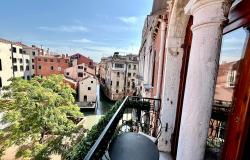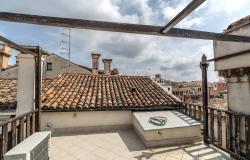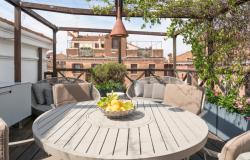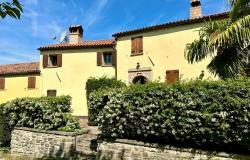It’s an unlikely sight as you approach the Euganean Hills (in the Veneto region) when driving eastwards across the endlessly flat plain of northern Italy. Suddenly, 17 symmetrical cones appear as if from nowhere and you can tell by their shapes that these were once volcanoes. Even though they’re extinct, there is still geothermal activity here. The area is famous for its hot springs and mud cures (“Best mud in Italy,” say the locals). Best of all, though, is the sense of a little unspoilt world of time-honoured traditional ways in a landscape that is breathtakingly beautiful.
You might say that walking in these hills began with Shelley, who wrote his poem Lines written on the Euganean Hills after climbing to the summit of the highest peak, Monte Venda. These days, Italian hikers meet once a year to do the same climb and recite the poem at the top. Imagine English hikers doing the same thing with, say, Dante. Not a chance!
There are several walks around the foothills of Monte Venda. One side has sweet chestnut forests where you risk being bombed on autumn walks by the spiky green balls, and have to try to avoid the hundreds of small lizards darting about on the path in the last of the season’s sunshine. On the western slopes there’s a small pond where there are dragon flies, turtles and a sub-alpine species of newt, which is blue. The whole area is a nature reserve, so all 17 recommended trails are well maintained with notice boards which provide information about local flora and fauna.
 Given that all the walks are circular and over similar terrain, you might think that they’d be much the same, but you’d be wrong. Each has its own character. Some of the hills have been quarried, for paving the alleyways of Venice: the hard ridged stone has a non-slip quality ideal for a city based on water. The quarry hollows, such as on walk 15, the Ferro di Cavallo (horseshoe walk), create microclimates where plants such as prickly pears flourish. It was on this walk that we came across a magnificent salamander, black with bright yellow spots, in the middle of the wooded path over the railway tunnel. As we stopped to marvel at the view over the vineyards towards Catajo Castle, the salamander lazily crawled away into the undergrowth.
Given that all the walks are circular and over similar terrain, you might think that they’d be much the same, but you’d be wrong. Each has its own character. Some of the hills have been quarried, for paving the alleyways of Venice: the hard ridged stone has a non-slip quality ideal for a city based on water. The quarry hollows, such as on walk 15, the Ferro di Cavallo (horseshoe walk), create microclimates where plants such as prickly pears flourish. It was on this walk that we came across a magnificent salamander, black with bright yellow spots, in the middle of the wooded path over the railway tunnel. As we stopped to marvel at the view over the vineyards towards Catajo Castle, the salamander lazily crawled away into the undergrowth.
Local farmers don’t seem to mind that the wild boar living in the hills steal some of their grapes.
“It makes the meat sweeter,” is the reply as they tap their noses knowingly and look forward with relish to hunting at the week end.
From walk 10, the Monte Gallo walk, you can look down on one of the most important water gardens in Italy at Valsanzibio. Fountains, white statues contrasting with dark green topiary, a maze and “water tricks” all look cool and tempting on a hot summer’s day. You can even see Rabbit Island where the moated warren houses dozens of tame rabbits of all shapes and sizes.
Each walk has its own best season. From late March to April, Monte Gemola (walk 3) comes to life with a dense cloud of almond blossom through which you walk to the Villa Beatrice d’Este with its little natural history museum. Slightly later, a walk round Monte Fasolo (walk 12) to the sound of cuckoos will take you past clumps of wild asparagus with cherry blossom here and there. Wild orchids are to be found on almost all the walks, and one of the delights of late springtime is to look down on the bright red rectangles of poppy fields around Arqua Petrarcha.
My favourite autumn walk is Monte Calbarina and Monte Piccolo (walk 7) where a track through pollarded willows (which produce supple branches for tying vines) takes you up to stretches of meadow dotted with wild deep purple Michaelmas daisies. The views from this stretch, over to the village of Arqua Petrarcha, nominated one of the most picturesque in Italy, give you a crescent of cones with glimpses of the flat plains beyond. Small wonder that the poet Petrarch chose to end his days here. His remarkably well-preserved late 13th century house can be visited.
At the foot of Monte Calbarina, just before you get to Arquà Petrarcha, is Lake Costa. This is the largest thermal basin in the hills, kept at a constant minimum temperature of 18 degrees because it is fed by upland streams where the water emerges at 45 degrees centigrade. From above, you can see that the soil around the lake is extremely rich, black and fertile. This is because there is peat here, from a time in the Bronze Age when the lake was larger, and there is evidence that people lived along the margins in stilt houses.
The presence of so many hot water springs lends an air of magic and mystery to the landscape in winter. For centuries farmers have channelled the naturally hot streams into ditches around their fields and vineyards. When the air is cold, these ditches become lines of vapour, a patchwork of steam hedges surrounding the skeletal black rows of leafless vines.
 Herons and storks live here in abundance. In winter they’re often to be seen warming their feet in the hot water channels, watching for the fish which are adapted to life in effervescent bath water. There are frogs too, including tree frogs, but the locals don’t leave many for the herons. Two Euganean villages hold frog festivals in May, when the menu for the great communal feasts is frog risotto followed by deep fried frogs’ legs with polenta.
Herons and storks live here in abundance. In winter they’re often to be seen warming their feet in the hot water channels, watching for the fish which are adapted to life in effervescent bath water. There are frogs too, including tree frogs, but the locals don’t leave many for the herons. Two Euganean villages hold frog festivals in May, when the menu for the great communal feasts is frog risotto followed by deep fried frogs’ legs with polenta.
The busiest time in the hills is during the vendemmia, the grape harvest. The vineyards are alive with the buzzing of ape s, (you’ll have seen them; they’re rather like motorised wheelbarrows. Ape means a bee, hence the buzzing) and the chattering of teams of pickers armed with secateurs.
It’s worth heading to Vo for the Grape Festival. Each village constructs a float made entirely of grapes, pulled by a tractor. Last year, better than the pyramid, the castle, the deep sea scene or the giant fox, the competition was easily won by an enormous replica of Michelangelo’s David, correct in every anatomical detail, except that it was the green of a million grapes. After processing twice round the main square, poor David was pulled to pieces and consumed, a fantastic reward for all that wonderful hill walking.
Further Information
www.turismopadova.it/itinerari/Colli
Illustrated leaflets and maps for all 17 walks can be picked up in local restaurants and tabacchi, and there are English versions in the two main tourist offices in Abano Terme and Montegrotto.
How to get there
The nearest airports are Venice, Bologna and Treviso.
They are all served by no frills flights. You’ll need to hire a car.
Where to stay
Accommodation ranges from basic alberghi in Galzignano Terme and Battaglia Terme from 50 euros per room per night, to luxury spa hotels in Abano Terme and Montegrotto. (see website for details.)
*Chek out our Travel to Veneto Guide
*More news about Veneto
*Information about food in our Foodie Fun in Veneto
*The weather in Veneto
*Map of Veneto
*Accommodation in Veneto









